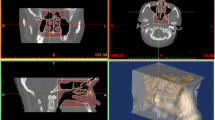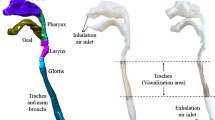Abstract
Knowledge of airflow characteristics in nasal cavity is essential to understand the physiological and pathological aspects of nasal breathing. Several studies have utilizedphysical models of the healthy nasal cavity to investigate the relationship between nasal anatomy and airflow. Since the final goal of these works is their contribution to the diagnosisand treatment of nasal diseases, the next step on this topic is naturally studies for disordered nasal cavities. In this paper, as the first application, airflows in the normal and abnormal nasal cavities with adenoid vegetation are investigated experimentally by PIV, and comparisons of both cases are appreciated. Dense CT data and careful treatment of model surface under the ENT doctor’s advice provide more sophisticatedcavity model. The CBC PIV algorithm with window offset is used for PIV flow analysis. Average and RMS distributions are obtained for inspirational and expirational nasal airflows. Airflow characteristics that are related with the abnormalities in nasal cavity are presented.
Similar content being viewed by others
References
Bockholt, U., Mlynski, G., Mueller, W., 2000, “Rhinosurgical Therapy Planning via Endonasal Airflow Simulation,” Computer Aided Surgery, Vol.5, pp. 175–179.
Chometon, F., Gillieron, P. Laurent, J., Ebbo, D., Kos-man, F., Lecomte, F., Sorrel-Dejerine, N., 2000, “Aerod-ynamics of Nasal Airways with Application to Obstruction,” Proc. FLUCOME 2000, Canada.
Di Martino, E., Mlynski, G., Mlynski, B., 1998, “Einf-luss der Adenoidhyperplasie auf die Nasale Atemstroemung,” Larygo-Rhino-Otol., Vol. 77, pp. 272–274.
Girardin, M., Bilgen, E., Arbour, P., 1983, “Experimental Study of Velocity Fields in a Human Nasal Fossa by Laser Anemometry,” Ann. Otol. Rhinol. Laryngol., Vol. 92, pp. 231–236.
Hahn, I., Scherer, P. W., Mozell, M. M., 1993, “Velocity profiles measured for airflow through a large-scale model of the human nasal cavity,” J. Appl. Physiol., Vol. 75, pp. 2273–2287.
Hess, M. M., Lampercht, J., Horlitz, S., 1992, “Experimentelle Untersuchung der Strombahnen in der Nasenhaupthoehle des Menschen am Nasen-Modell,” Laryngo-Rhino-Otol., Vol. 71, pp. 468–471.
Hopkins, L. M., Kelly, J. T., Wexler, A. S., Prasad, A. K., 2000, “Particle Image Velocimetry Measurements in Complex Geometries,” Exp. Fluids, Vol.29, pp. 91–95.
Kelly, J. T., Prasad, A. K., Wexler, A. S., (2000) Detailed flow patterns in nasal cavity, J. Appl. Physiol. Vol. 89, pp. 323–337.
Keyhani, K., Scherer, P. W., Mozell, M. M., 1995, “Numerical Simulation of Airflow in the Human Nasal Cavity,” J. Biomech. Engin., Vol. 117, pp. 429–441.
Kim, S. K., 2001, “An Experimental Investigation on Flow Field in a Pipe with Sinusoidally Wavy Surface by PIV,” KSME Int’l J., Vol. 15, No. 12, pp. 566–569.
Kim, S. K., Son, Y. R., 2002, “Particle Image Velocimetry Measurements in Nasal Airflow,” Trans. KSME B, Vol. 26, No. 6, pp. 566–569.
Kim, S. K., Son, Y. R., 2003, “An Investigation on Airflow in Abnormal Nasal Cavity by PIV,” Pros. PSFVIP4, Shamonix, F4095.
Park, K. I., Brucker, C., Limberg, W., 1997, “Experimental Study of Velocity Fields in a Model of Human Nasal Cavity by PIV,” Proc. 7th Int’l. Conf. Laser Anemometry Advance & Appl.
Scherer, P. W., Hahn, I. I., Mozeil, M. M., 1989, “The Biophysics of Nasal Airflow,” Otol. Clinics N. Ame., Vol. 22, No. 2, April, pp. 265–278.
Schreck, S., Sullivan K. J., Ho, C. M., Chang, H. K., 1993, “Correlations Between Flow Resistance and Geometry in a Model of the Human Nose,” J. Appl. Physiol., Vol. 75, pp. 1767–1775.
Subramaniam R. P., Richardson, R. B., Morgan, K. T., Kimbell, J. S., 1998, “Computational Fluid Dynamics Simulations of Inspiratory Airflow in the Human Nose and Nasopharynx,” Inhal. Toxicol., Vol. 10, pp. 473–502
Swift, D. L. and Proctor, D. F., 1977, “Access of air to the Respiratory Tract,” Respiratory Defence Mechanisms: Part I, New York: Dekker, pp. 63–93.
Author information
Authors and Affiliations
Corresponding author
Rights and permissions
About this article
Cite this article
Kim, S.K., Son, Y.R. Investigation on airflows in abnormal nasal cavity with adenoid vegetation by particle image velocimetry. KSME International Journal 18, 1799–1808 (2004). https://doi.org/10.1007/BF02984328
Received:
Revised:
Issue Date:
DOI: https://doi.org/10.1007/BF02984328




